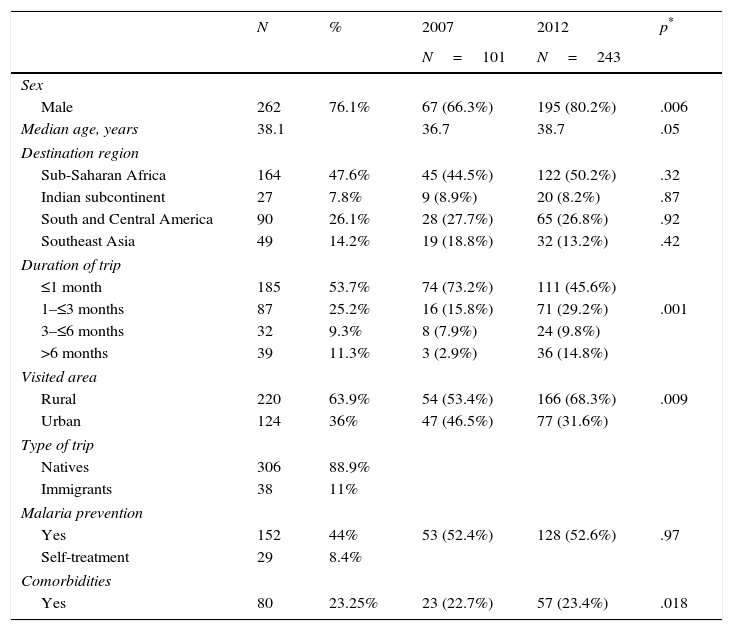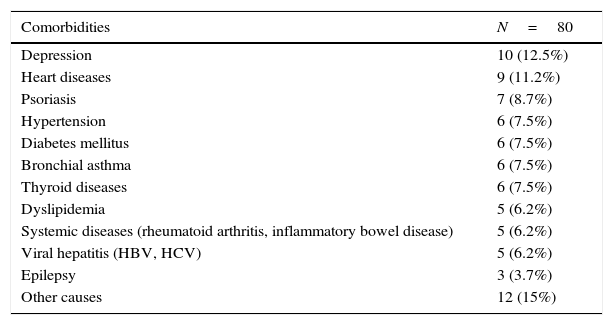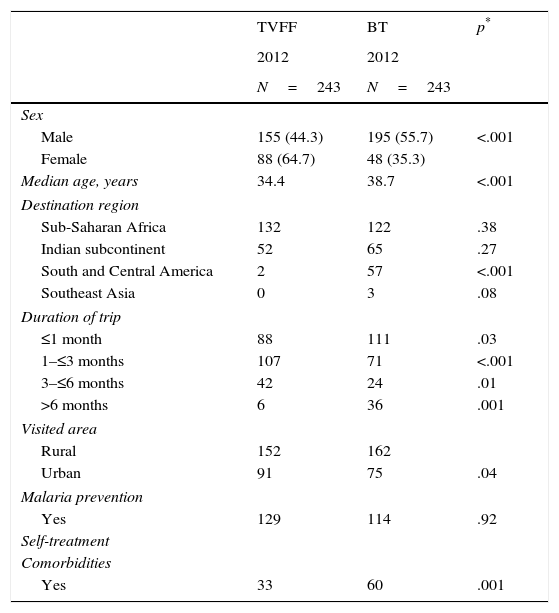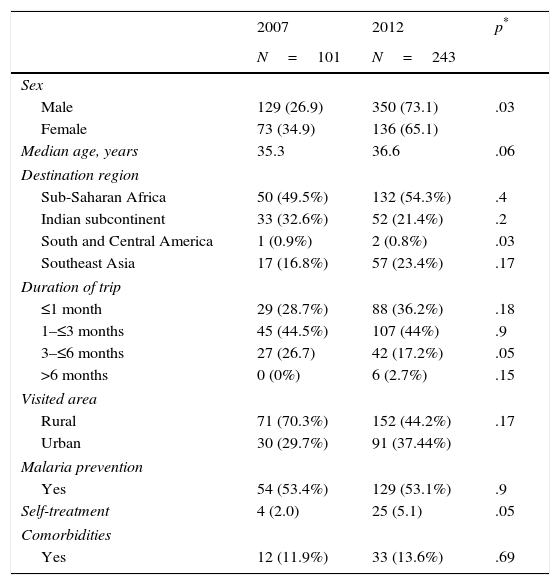The economic world crisis has led to the migration of European workers to developing countries with a high incidence of infectious diseases. The objective of this study was to assess whether this context has produced an increase in the risks to international travelers for work reasons (TWR).
MethodsObservational, retrospective study. The study population included TWR who were attended before traveling at an International Health Unit in the year 2007 (the year before the initiation of the European crisis) and in the year 2012 (when the structural crisis was established). A comparative socioeconomic analysis was performed as well as an analysis of the risk factors present in both groups.
ResultsIn 2007 and 2012 a total of 9197 travelers were attended. Of these, there were 344 TWR (3.4%); 101 TWR (2.8%) in 2007 and 243 TWR (4.5%) in 2012 (p<.001). The average age of the travelers was 38.1 years (SD: 10.57). The most common destination was Sub-Saharan Africa, in 164 (47.6%) of the cases. Malaria chemoprophylaxis was prescribed to 152 travelers (44%) and 80 presented comorbidity (23.25%). The TWR from 2012 presented a significantly greater age (p=.05), more comorbidity (p=.018) and a greater proportion of stays in rural areas (p=.0009) for longer time periods (p=.001).
ConclusionsAt 5 years from the start of the economic crisis, there was a change in the profile of TWR. Their number has increased significantly, as has the proportion who present risk factors for contracting imported diseases. The International Health Units should adapt to these new circumstances and adopt preventive measures for this population.
La crisis económica mundial condiciona la migración de trabajadores europeos hacia países en vías de desarrollo con alta incidencia de enfermedades infecciosas. El objetivo de este estudio es valorar si este contexto produce un aumento de los riesgos de los viajeros internacionales que se desplazan por motivos laborales (VML).
MétodosEstudio observacional retrospectivo. La población de estudio fueron los VML atendidos antes de su viaje en una Unidad de Salud Internacional durante los años 2007 (año anterior al inicio de la crisis europea) y 2012 (con la crisis estructural establecida). Se realizó un análisis comparativo sociodemográfico y de los factores de riesgo presentes entre ambos grupos.
ResultadosEn 2007 y 2012 se atendieron un total de 9.197 viajeros. Los VML fueron 344 (3,4%); en 2007, 101 (2,8%) y en 2012, 243 (4,5%) (p<0,001). La edad media de los viajeros fue de 38,1 (DE: 10,57) años. El destino más frecuente fue África subsahariana con 164 (47,6%) casos. Se prescribió quimioprofilaxis antipalúdica a 152 (44%) y presentaban comorbilidades 80 (23,25%). Los VML del 2012 presentaron significativamente mayor edad (p=0,05), más comorbilidades (p=0,018), y mayor proporción de estancias en zonas rurales (p=0,009) durante periodos más largos (p=0,001).
ConclusionesA 5 años del inicio de la crisis económica, existe una variación en el perfil del VML. Su número ha aumentado significativamente, así como la proporción de los que presentan factores de riesgo para contraer enfermedades importadas. Las Unidades de Salud Internacional deberían adaptarse a las nuevas circunstancias y adoptar medidas preventivas en dicho colectivo.
Article
Diríjase desde aquí a la web de la >>>FESEMI<<< e inicie sesión mediante el formulario que se encuentra en la barra superior, pulsando sobre el candado.

Una vez autentificado, en la misma web de FESEMI, en el menú superior, elija la opción deseada.

>>>FESEMI<<<











